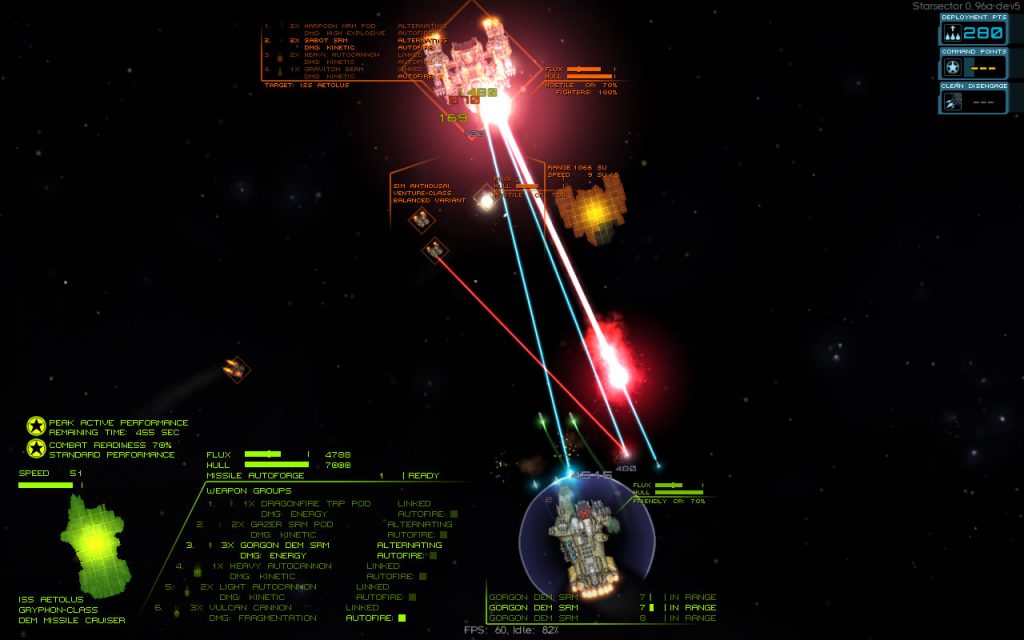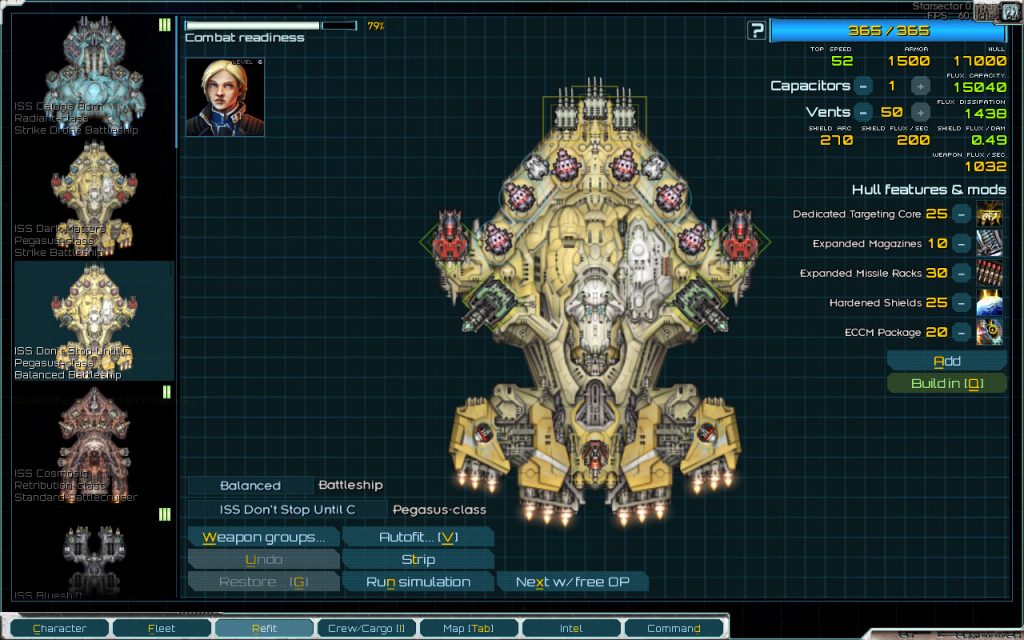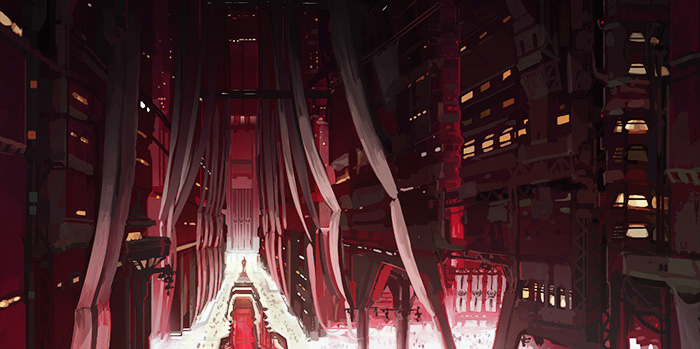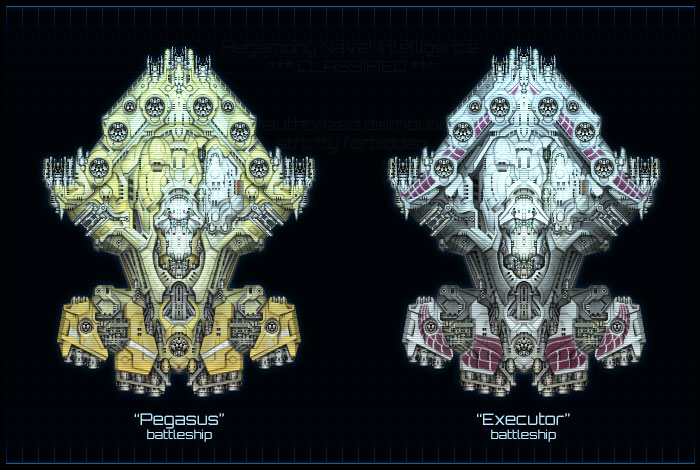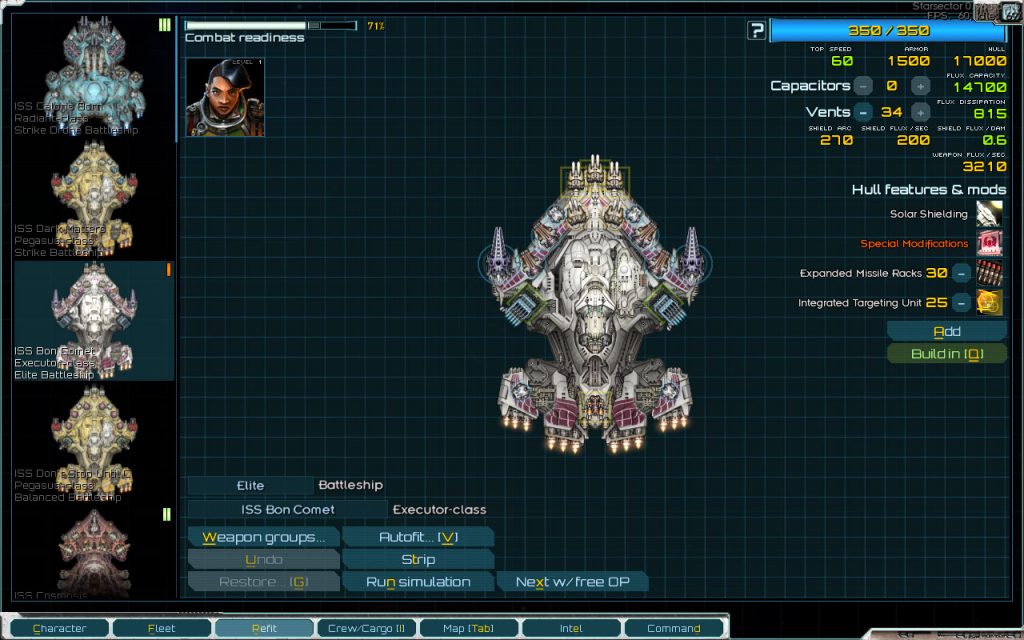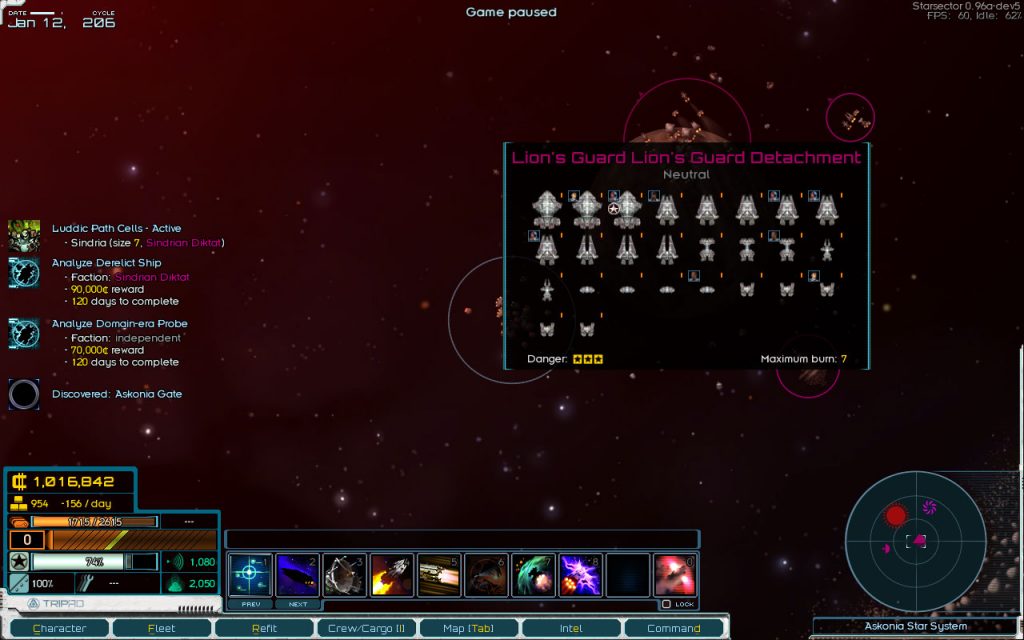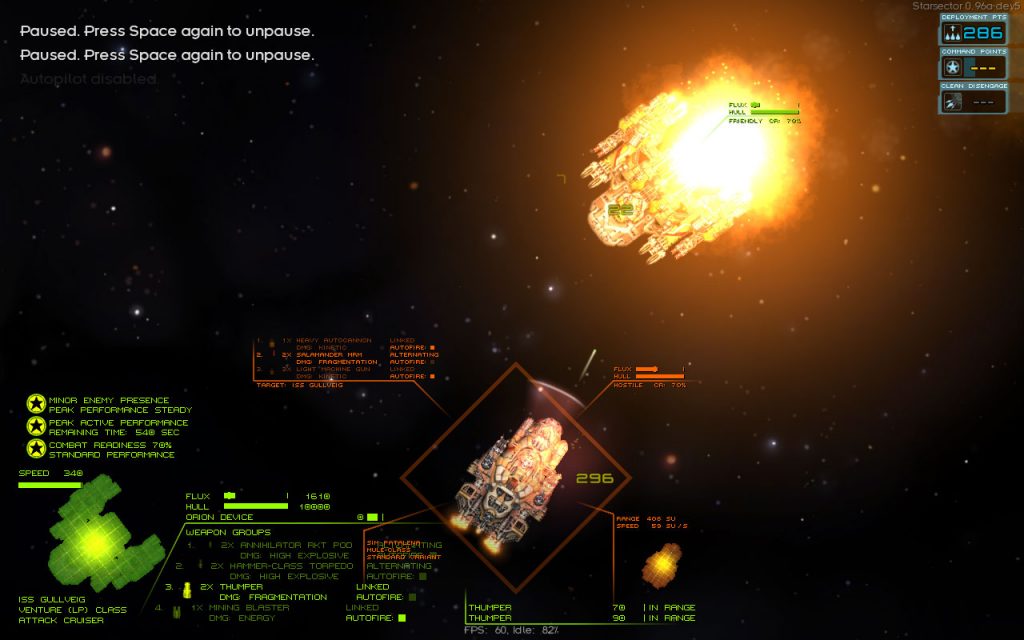Uniquifying the Factions, Part 2
Part 1 of this blog post series is here. Here in part 2, we’ll dive into making the remaining factions more memorable!
Persean League
“An alliance formed to counter Hegemony domination of the Sector. Members of the League don’t necessarily agree on all issues, domestic or otherwise, and may even come into armed conflict with one another. But the League is united when it comes to the Hegemony who they consider to be illegitimately enforcing martial law in the name of the Domain, a dead political entity. The League, by its laws, unites against other external threats such as particularly meddlesome megacorporations, warlords, and the Luddic Path.”
The League’s core identity is going to be that of using midline ships. However, because those are going to be sprinkled in throughout the other factions, the League will also have access to a brand-new missile weapon lineup: directed energy munitions, or, put more simply, missiles that fire lasers when they get close enough to their target. In addition, it’ll get a new battleship (to go along with the already-existing Conquest-class, which is a midline battlecruiser.)
There are a few other smaller changes and tweaks, all aimed towards making League fleets more unique, too:
- (Near) exclusive access to the Monitor-class frigate – it’s an extremely hard nut to crack, which makes it a high-impact ship. So, despite being small, it’s something that’s easy to remember and gives fleets that have it a very distinct feel to fight against – and it can also form a nice front-line screen for missile ships behind it.
- Access to only a limited set of ballistic weapons; for example the Heavy Autocannon is the League’s signature ballistic anti-shield weapon; it has no access to the more elite ballistics that the Hegemony goes, for example
- Fighters – League fleets often have some fighter support, but with an exclusive doctrinal focus on interceptors rather than bombers
DEM Missiles
To make sure the distinctive feel of the missiles really comes across, the League will use these to the exclusion of all other missile weapons. This means that the set of new missile weapons needs to cover the major missile roles – but at the same time, we don’t want to add a lot of “same thing, just looks different” kinds of weapons. Some of that may happen, sure; occasionally it’s ok to make something new and shiny just for feel/coolness reasons. Ideally, though, these would fill their roles while also being mechanically different from other missiles in those same roles.
Gorgon DEM
This is a basic “finisher” type of missile. Compared to the Harpoon – its closest competitor among conventional missiles – it has shorter range, but is harder to stop with point-defense, because it doesn’t need to get all the way in to deal its damage. It also deals energy damage instead of high explosive, making it somewhat worse vs armor – but it has a slightly higher ammo count. It comes in small and medium sizes.
Gazer DEM
An anti-shield missile. Both it and the Sabot – the standard shield-breaker missile – operate from range, but the Gazer opens up from a much longer range – and, critically, the beam it fires lasts for a full ten seconds, creating a long window of opportunity, but dealing much less burst damage than the Sabot. It also comes in small and medium versions.
Dragonfire DEM Torpedo
The big damage dealer, firing its brief, high-powered beam from long range. It’s much harder to stop with point-defense than conventional torpedoes, but easier to shrug the damage off if the target’s shields are up. It’s also sort of an up-sized version of regular torpedoes – it has a medium and a large version, but the ammo counts are low, in the range that would be found conventional torpedoes one weapon slot size smaller. Overall: harder to stop, less shots.
Hydra MDEM
This one doesn’t have a ready equivalent among the other missiles. It fires a missile that splits into multiple warheads, which then bracket the target from both sides and fire relatively low-powered beams into it. Tougher targets can often shrug this damage off – especially since chances are, it’ll be hitting undamaged armor on the sides of the ship, rather than on its front – but smaller targets can get overwhelmed, making this a good choice for clearing out smaller combatants. It also has more ammo than usual, to give it some extended usefulness even against the tougher targets. This one only has a large-mount version.
Between all these, we have a missile lineup that covers all the bases.
IR Autolance
In addition to all these missiles, the League also gets a new medium energy weapon (though, a few other factions get access to it as well, if less prominently). One core design concern for midline ships is that they have all these energy slots, but do not have the flux stats to support the use of the heavier energy weapons. It’d be nice to expand the set of energy weapons that are broadly useful in medium energy slots on midline ships, and the IR Autolance is intended to be just that.
It’s a beam weapon with a new mechanic – the beam fires continuously, but uses up charges while it does so, making it a weapon that deals burst damage, with its sustained weapon being quite low – limited by the rate at which it regenerates its charges.
Its flux generation is extremely low, and it deals fragmentation damage, making it virtually useless against shields (in fact, when set on autofire, it’ll only fire a small fraction of its charges into shields), and poor against most armor. It can deal crippling hull damage, though, and wipes out most fighters easily. Its high range – the standard 1000 units for beam weapons – makes it especially effective at that job, as does its burst nature – enemy fighters usually come in waves, letting it regenerate charges.
And, finally, it costs fewer ordnance points than usual to mount, making it a budget choice with a specific niche. Compared to the Phase Lance – another medium energy weapon that’s good vs fighters – it’s better at that particular job, but does not compare at all in terms of anti-armor damage; it’s simply not suitable as the “main” armament for any sort of ship, while the Phase Lance is. The IR Autolance also deals considerably more burst damage to hull, making it a useful finisher in some specific tactical situations.
Pegasus-class Battleship
Now, we get to just about my favorite thing – designing new ships! There’ll be a bunch more of that in this post, so I hope you like this topic as much as I do.
Since this ship is specifically intended for the League, it makes sense that it should showcase the League’s unique weapons – so, it’ll be a missile-centric battleship. And, of course, it’ll be a midline ship, since that’s what the League is using.
The Conquest – a midline battlecruiser – already has heavy missile firepower (two large slots, two medium), so the Pegasus will need more than that. Let’s say four large missile slots; that’s a lot, but I wanted to see if it could work. Let’s throw in Fast Missile Racks – a quicker reload for missiles – as a ship system, too; going pretty much all-in on the missiles here, since that’s the ship’s main feature.
Aside from all the missiles, the ship has very poor flux stats, and a bunch of medium ballistic, energy, and hybrid slots – it has no access to large direct-fire weapons.
Since it’s a battleship, it needs to be able to hold up pretty well under fire, but since it’s a midline ship, that means its armor is average. Combined with its poor flux stats, this means it needs to have a very high shield efficiency, but fortunately we do have that balance lever, so it’s not a problem.
I spent a pretty good amount of time playtesting this ship, with the main concern being just how much four large missile slots – backed up by rapid-reload – could do. A few problems came up, but I think they more highlighted issues with some of the large missiles than a problem with the ship.
For example, the Squall MRLS fires a stream of kinetic missiles – the missiles are difficult to shoot down, it has lots of ammo, and each burst lasts for a long time. It’s designed to suppress shields and create a window of opportunity (much like the Gazer DEM, in that sense), but each individual missile packs enough punch that it can do appreciable damage vs armor, too. With a smaller number of mounts, it’s not a big deal – but combine four of these, and eliminate the cooldown, and it overwhelms the shields of any enemy, and eventually pounds them into scrap.
The solution was an adjustment to how the Squall works – each missile now has a “resonator” warhead that deals additional damage to shields (keeping the total anti-shield damage the same as before), but its base damage – which is what gets applied to armor/hull – is reduced. I think that leaves the Squall in a good place, regardless, since it doesn’t affect its performance in its main role, but if it turned out to be too weak, it could be, for example, made less expensive to install. Overall, I think it’s a positive change for the missile, giving it a better-defined niche, and it took some stress-testing outside the hitherto-normal parameters to identify this.
Another potential problem would be just stacking an excessive number of high-damage, dumbfire torpedoes. For example, if you’re launching four Hammer Barrages at a time, there’s just not going to be any help for that being a bit on the ridiculous side damage-wise. To forestall this possibility entirely, two of the ship’s large missile launchers face just about backwards.
To recap, the League gets a solid identity as the primary “midline faction” – with a battleship and a battlecruiser that no other major faction has access to – and its uniqueness is further enhanced with a new missile lineup. And, League territory is now also a place for the player to reliably buy DEM missiles, along with a few other signature weapons.
Sindrian Diktat
“The Sindrian Diktat is a polity founded in a relatively recent Hegemony military intervention in the Askonia system led by Admiral Philip Andrada, formerly of the Hegemony Navy. Andrada’s Hegemony psych profile describes him as ‘intelligent, charismatic, yet prone to narcissistic excess’. In his words, the Diktat was ‘formed in the crucible of the Askonia Crisis and with it a new people: a race of humans with emboldened spirit and clarity of purpose; stronger, possessing the will and determination to overcome the divisions and petty parliamentary politics that bred only chaos when tested by the collapse of the Gate System.’ Considered by the Sector at large to be a military dictatorship.”
In plainer language, what we’ve got in the Diktat is a dictatorship run by The Lion of Sindria, Supreme Executor Philip Andrada – a megalomaniac who has established a cult of personality around himself. The relevant question for this blog post is, how is this reflected in the Diktat’s ships?
Being a dictator, he’s keen on the military. Being a former admiral, he fancies himself an expert on naval matters. Being a megalomaniac, no-one is going to tell him when something might possibly not be the best idea in the known universe. This combination has a predictably negative effect on the Diktat’s military.
The Diktat is special in that it has two different militaries – the “regulars”, and the more elite “Lion’s Guard”, charged with protecting Andrada. The latter gets more of his personal attention, with obvious results.
Midline ships feel right for the regulars; they’re generally grayish and bleak. The Lion’s Guard will get special versions of these, with the aesthetic being more “stark” than bleak; more on that later. Let’s say neither uses carriers – “the individualism commonly displayed by the so-called ‘fighter jocks’ has no place in a society united around completing the Supreme Executor’s Great Plan”, or something.
Unique Weapons
What sort of a megalomaniacal dictator wouldn’t have a top-secret weapons program? The challenge here is to make interesting and useful weapons that are at the same time terrible for the Diktat, to underscore the nature and effect of Andrada’s personal involvement in military affairs.
Or, rather, specifically terrible for the Diktat’s new capital ship (more on that in a bit), which is where they would see by far the most use, with access to these weapons being restricted only to elite of the elite.
Kinetic Blaster
This is a short range medium energy weapon much like the Heavy Blaster, but dealing “kinetic” – anti-shield – damage. It’s pretty great on high-tech ships that have the flux stats and the speed to use it well. On the Diktat’s midline ships, it’s wholly outclassed by the options offered by their ballistic weapon slots.
“Long-range readings provided by HEGINT asset suggest weapon system integrates elements of SUPER ALABASTER technology to harness previously unutilized anti-shield effect. Native Askonian physics establishment, depleted post-Opis, not considered capable of such breakthrough [ref rep HEGINT/ASKON-M38-12]. Conclude: with near certainty, TT technical assistance to Sindrian Mutiny.”
– classified report to the High Hegemon
Gigacannon
An unnecessarily long energy weapon, with an unnecessarily grandiose name, this one requires a large mount. It deals a huge amount of energy damage, but has a very low rate of fire. It’s actually quite efficient, but its range is on the low side. A high-tech ship could use it well – flux efficiency is a valuable stat, and it wouldn’t mind the range since it’s no worse than the range of its usual armaments.
“High-ranking naval officers on Ultradyne Askonia Combine board of directors rammed through large-scale AM projector weapon development despite objection of engineering lead. Project allegedly initiated at personal behest of so-called Executor [traitor Andrada]. HEGINT assets report test firing displays dramatic power output but weapon system integration projected to reduce enemy warfighting capability in fleet action due to doctrinal inefficacy. Recommend no sabotage operation.”
– classified report to the High Hegemon
The Gigacannon might be a pretty decent weapon on, say, the Sunder-class destroyer. The Diktat’s capital ship is a slow battleship, though, and this weapon’s lack of range or sustained damage makes it nearly useless there. Speaking of:
Executor-class Battleship
The Diktat needs a capital ship, but both the midline capital ships are already used by the League. How would a dictatorship like this go about getting one, anyway? They’d probably steal the design from a likely neighbor – in this case, the League. So, let’s say they stole the design of the Pegasus, and applied some modifications to make it more suited for operations in the Askonia system. It’s named the Executor-class because of course it is, and it’s not named the Supreme Executor-class because there’s only one of those.
Naturally, the (one and only) Supreme Executor was personally involved in adapting the design, sharing his valuable insights. The battleship gets a built-in “Special Modifications” hullmod reflecting the Supreme Executor’s input:
During an inspection of an early prototype hull, the Supreme Executor was heard to comment unfavorably on the exposed conduits running along the passageways, and the danger these must pose to the brave, loyal crew of the vessel under combat conditions.
The new chief designer, with input from the Supreme Executor himself, has modified the blueprints to include blast-proof insulated paneling.
If the passages are a bit narrower and more difficult to navigate – and if the conduits are slightly more prone to overheating, and more difficult to access – then surely it is a small price to pay to protect the lives of the Supreme Executor’s most loyal servants.
In mechanical terms, it’s a d-mod – higher crew casualties, reduced flux dissipation, increased time to repair disabled weapons and engines. Nothing too drastic, though; the ship still works.
In addition, as we’ve gleaned from the weapons program, the Supreme Executor is a fan of energy weapons. Thus, two of the Pegasus’ large missile slots have been converted to mount energy weapons.
The Executor also gets built-in Solar Shielding – to facilitate operations in the corona of Askonia, which is a red super-giant. Alas, the maximum ordnance points of the hull are reduced by the cost of the hullmod, so it’s a slight reduction in flexibility rather than an improvement over the Pegasus.
Both the normal military and the Lion’s Guard get access to the Executor; the Lion’s Guard however are the only ones lucky enough to also have full access to the fruits of the weapons program. Their elite Executor variant is loaded for bear – with a pair of Gigacannons, and a quartet of Kinetic Blasters. On the firing range, its performance is exceptional. In actual combat, it’s lucky to even fire any of these.
The normal Diktat military Executor has a more sensible loadout, with a pair of long-range High Intensity Lasers and reasonable support weapons. Despite some downsides, it can be a capable ship, if it’s outfitted by someone with a firmer grasp on reality.
Lion’s Guard
In addition to the elite loadout for the Executor, the Lion’s Guard also gets access to equally-elite versions of all of the regulars’ midline ships. They have a similar “stark” look and sport the Diktat’s colors. All of these “benefit” from the built-in “Special Modifications” hullmod, as well as built-in-at-cost Solar Shielding. Unlike the Executor, these don’t get access to the special weapons.
The officers of the guard are selected for loyalty and doctrinal purity over all other considerations. The guard hasn’t been involved in a major war since the Diktat’s founding, and anti-piracy actions are generally beneath them – the kind of dirty work best left to the regulars.
All in all, they’re very much a parade-ground army – arguably, their primary function is boosting the Supreme Executors ego and image. It’s certainly the function they’re optimized for, at any rate.
Tri-Tachyon
“The most powerful megacorporation in the Sector after the fall of the Domain gate system, Tri-Tachyon specialized in cutting-edge AI development (including several notable cases of violating the Domain ban on autonomous alpha+ level AI) and exotic high-power devices (starship engines and warp drives, power generators, energy converters, forcefields). Since the Collapse, Tri-Tachyon has vastly diversified its operations and insinuated itself throughout the Sector. Even hostile factions, paranoid of hardwired backdoors, find themselves forced to employ standard Tri-Tachyon devices, beginning with the ubiquitous Tri-Tachyon PDA.”
The quintessential high-tech faction, plus phase ships. For capital ships, it gets the three existing high-tech ones – the Paragon, the Odyssey, and the Astral-class carrier. In the current release, there’s an even split between warships, phase ships, and carriers – instead of that, it’ll be a split between warships and phase ships (leaning more towards phase ships), with carriers/fighters only coming into play when the fleet gets an Astral.
Tri-Tachyon already had a strong identity, so there’s not too much to talk about – this is just leaning into it a little more, giving their capital ships more opportunity to shine. Weapons and fighters-wise, they have a good range of options available, including the most elite ones.
[REDACTED]
Also known as the Remnants – automated AI-controlled ships, built by Tri-Tachyon and left over on the fringes of the Sector after the wars between the Hegemony and Tri-Tachyon, fought over the use of AI. I usually try to avoid talking too much about these because of spoilers, but I’m sorely tempted to here, just because some of the new stuff they get is so cool. I’ll compromise by keeping things a bit vague and going light on the screenshots!
The Remnants have a lineup made up of ships unique to their faction, so making them more distinct is not a concern. Instead, changes and additions here are about expanding their lineup to both make them more varied opponent to fight, and to add some more option for the player that goes with the “Automated Ships” skill and can add these to their fleet.
Nova-class Drone Battlecruiser
A battlecruiser is a natural ship to add to the lineup – they already have a battleship, the Radiant-class, and another capital ship will have high-impact as far as increasing variety.
Given that it’s a battlecruiser, it should generally speaking get a mobility-focused ship system, since mobility is a ship class-defining feature. And Remnant ships are high tech, and uncrewed, so it makes sense that they would be able to both produce and handle extremely high acceleration.
So! It it gets a new ship system, “Nova Burst” – what’s more high-tech than using lasers to generate a miniature nova behind the ship, containing and directing its force to propel the ship forward at an acceleration no meat-bag could hope to survive?
This is, of course, a variation on the Orion Device ship system from the previous post, but it moves the ship both much more quickly and much farther per activation – and has a much more limited number of charges that regenerate more slowly. It’s a system that lets the ship get in close to an enemy, but doesn’t help much with getting away.
The ship is designed to generate a lot of frontal firepower, at the expense of being vulnerable to being flanked, and to fighters. It’s capable of jumping on an exposed target and delivering an overwhelming alpha strike, but it also needs to be used with care so that doing this doesn’t leave it vulnerable to a counter-blow.
Apex-class Heavy Droneship
Until now, the Remnants had only one cruiser – the Brilliant – so this definitely a good place to add some variety. I really like the idea of having a larger ship with a bunch of Terminator Drones, and the Terminator Sequence ship system – that turns these drones into highly damaging, guided missiles. (Incidentally, doing this involved making some AI improvements, both in how it uses this system and how well aware it is of the danger posed by it.)
However, using Termination Sequence means no mobility system – and on a ship armed with energy weapons, which have a lower range than ballistic ones, this can be a problem. Anything faster would just tear it apart, and it would have a hard time closing to energy weapon range. This is, for example, why the Paragon-class battleship has the built-in “Advanced Targeting Core” hullmod – it’s a slow ship, and this means it needs long-range weapons not to be outclassed.
Initially, I’d experimented with just having a bunch of hybrid weapon mounts on the Apex, letting it mount ballistic weapons. In practice, though, that just turned into “put a bunch of the longest-ranged kinetic (i.e. anti-shield) ballistics in there” being the clear-best build, especially since the ship has an endless supply of drone-missiles capable of dealing with armor.
So, instead: it gets a new built-in hullmod, the “Energy Bolt Coherer”, which increases the base range of non-beam energy weapons, basically bringing them up to the ballistic range band. Alongside that change, the ship’s main battery is changed to the “synergy” slot type, meaning it can mount energy or missile weapons.
Usually a synergy slot would get missiles in it – especially on a slower ship. Flux-free damage, with potentially longer range, is just too good to pass up. However, with the Coherer increasing the value of energy weapons, and with the availability of drone-missiles reducing the value of additional missile weapons a bit, this should leave the ship with more viable and varied loadouts. Plus, having longer range on energy weapons should let them get more use in some unusual situations – say, applying long-range shield pressure with a battery of Pulse Lasers, or suppressive fire with Ion Pulsers – and that’ll be fun to see.
The Brilliant – the other cruiser – loses its fighter bay (so that not every Remnant cruiser is about drones or fighters in some way), but gets Plasma Burn (a mobility system) to help differentiate it more strongly from the Apex.
Pirates and the Luddic Path
Neither of these are factions that need much help in the “has a personality” department – both sport a bunch of custom modifications of regular ships. Still, for the sake of fun, variety, and so on – I’ve added two new versions of the Venture-class cruiser. The stock version is basically a half-civilian ship, themed around planetary surveys and exploration, and is pretty much a brick in combat.
Venture (P)-class
Pirates are all about making questionable decisions vis a vis putting ever-larger weapons on hulls that were never meant for that. In the case of the Venture, an enterprising pirate ship surgeon (not, like, one from an advanced medical establishment – think the kind with a bonesaw) has decided to replace the mining drone bay with a rear-facing large missile slot.
To prevent the ship from having too much missile-based firepower – which would be a balance issue, especially if these were massed – I changed the medium missile slots to mount ballistic weapons instead.
Venture (LP)-class
The Luddic Path version of the Venture is unique in that it doesn’t have built-in Safety Overrides – the Pather engineers involved had bigger dreams. Instead, the drone bays are replaced with a crude version of the Orion Device. Is it a good idea in terms of having a well-rounded ship that fits well into some kind of fleet doctrine? Certainly not. On the other hand, it makes a big boom and goes really, really fast.
Independents
“Not a unified faction as such, the Independents are a loose category of polities and free agents unified more by a lack of association with a major faction than any shared qualities.”
So, not a faction per se, and certainly with nothing like a shared military doctrine. There’s no need for them to have a capital ship, let alone a faction-specific one – in fact, I’m not even sure there are any large-enough independent fleets in the game that would use them. Some of the larger patrols might, perhaps. Fortunately, “a mix of all sorts of tech levels, cruiser sized and smaller” turns out to be a pretty distinct faction identity when all of the other factions exercise a lot of restraint about mixing different tech levels so freely.
I should note that some independent-flagged fleets you see in-game actually use different ships and weapons lists, not the ones from this independent faction. For example, high-end mercenary fleets use a separate “Mercenary” faction to determine what ships end up in them, and that faction has access to most capital ships from all the other factions, all of the elite weapons, and so on.
And, if you’re not coming here from Twitter – here’s a shot of the Nova-class Drone Battlecruiser in action:
New Starsector blog post! "Uniquifying the Factions, Part 2"https://t.co/J2r71y7qDQ
Featuring several new capital ships, bomb-pumped laser missiles, and more [REDACTED]! pic.twitter.com/SVDcHfZOOh
— Alexander Mosolov (@amosolov) April 30, 2022
With that, back to work on other things!
Comment thread here.
Tags: design, factions, Persean League, ship design, Sindrian Diktat, weapons, [redacted]


